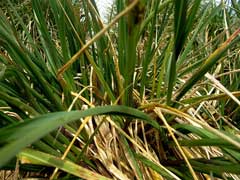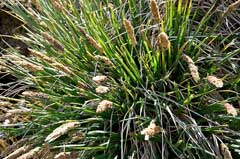 |
|
http://commons.wikimedia.org/wiki/User:Butterfly_voyages |
 |
| http://commons.wikimedia.org/wiki/User:Butterfly_voyages |
Translate this page:
Summary
Physical Characteristics

 Poa flabellata is a PERENNIAL growing to 2 m (6ft 7in). The species is hermaphrodite (has both male and female organs) and is pollinated by Wind.
Poa flabellata is a PERENNIAL growing to 2 m (6ft 7in). The species is hermaphrodite (has both male and female organs) and is pollinated by Wind.
Suitable for: light (sandy), medium (loamy) and heavy (clay) soils and prefers well-drained soil. Suitable pH: mildly acid, neutral and basic (mildly alkaline) soils. It cannot grow in the shade. It prefers moist or wet soil. The plant can tolerate maritime exposure.
UK Hardiness Map
US Hardiness Map
Synonyms
P. forsteri. Festuca flabellata.
Plant Habitats
Bog Garden; Cultivated Beds;
Edible Uses
Edible Parts: Stem
Edible Uses:
The base of the leaf stalk has a juicy and fleshy portion that is about 3cm long and as thick as an adult's finger[2]. It is a very sweet morsel with a nutty flavour[2, 105, 177].
References More on Edible Uses
Medicinal Uses
Plants For A Future can not take any responsibility for any adverse effects from the use of plants. Always seek advice from a professional before using a plant medicinally.
None known
References More on Medicinal Uses
The Bookshop: Edible Plant Books
Our Latest books on Perennial Plants For Food Forests and Permaculture Gardens in paperback or digital formats.

Edible Tropical Plants
Food Forest Plants for Hotter Conditions: 250+ Plants For Tropical Food Forests & Permaculture Gardens.
More

Edible Temperate Plants
Plants for Your Food Forest: 500 Plants for Temperate Food Forests & Permaculture Gardens.
More

More Books
PFAF have eight books available in paperback and digital formats. Browse the shop for more information.
Shop Now
Other Uses
References More on Other Uses
Cultivation details
Succeeds in any well-drained moderately fertile soil in a sunny position[200]. This plant is also likely to tolerate wet soils and maritime exposure, see its native habitat.
References Carbon Farming Information and Carbon Sequestration Information
Temperature Converter
Type a value in the Celsius field to convert the value to Fahrenheit:
Fahrenheit:
The PFAF Bookshop
Plants For A Future have a number of books available in paperback and digital form. Book titles include Edible Plants, Edible Perennials, Edible Trees,Edible Shrubs, Woodland Gardening, and Temperate Food Forest Plants. Our new book is Food Forest Plants For Hotter Conditions (Tropical and Sub-Tropical).
Shop Now
Plant Propagation
Seed - surface sow in the spring in a cold frame. Do not allow the compost to dry out. When they are large enough to handle, prick the seedlings out into individual pots and grow them on in the greenhouse for their first winter. Plant them out into their permanent positions in late spring or early summer, after the last expected frosts. Division in the spring. Very easy, larger divisions can be planted out direct into their permanent positions. We have found that it is better to pot up the smaller divisions and grow them on in light shade in a cold frame until they are well established before planting them out in late spring or early summer.
Other Names
If available other names are mentioned here
Native Range
SOUTHERN AMERICA: Argentina (Tierra del Fuego (southeast)), Chile (Magallanes)
Weed Potential
Right plant wrong place. We are currently updating this section.
Please note that a plant may be invasive in one area but may not in your area so it's worth checking.
Conservation Status
IUCN Red List of Threatened Plants Status :

| Related Plants
|
| Latin Name | Common Name | Habit | Height | Hardiness | Growth | Soil | Shade | Moisture | Edible | Medicinal | Other |
| Achnatherum hymenoides | Indian Millet, Indian ricegrass | Perennial | 0.6 |
7-10
| | LMH | N | M | 4 | 0 | 3 |
| Aegilops speltoides | Goatgrass | Annual | 0.6 |
0-0
| | LMH | SN | DM | 1 | 0 | |
| Aegilops triuncialis | Barbed goatgrass, Barb goatgrass | Annual | 0.3 |
8-10
| | LMH | N | DM | 1 | 0 | 0 |
| Agropyron elongatum | Tall Wheatgrass | Perennial | 1.8 |
5-9
| | LMH | N | DM | 0 | 0 | 3 |
| Agrostis capillaris | Browntop Bent Grass | Perennial | 0.4 |
3-10
| F | LM | SN | WeM | 0 | 0 | 4 |
| Agrostis perennans | Upland Bent, Upland bentgrass | Perennial | 0.9 |
0-0
| | LMH | SN | DM | 1 | 0 | 2 |
| Alopecurus aequalis | Shortawn Foxtail, Sonoma shortawn foxtail | Annual/Perennial | 0.3 |
0-0
| | LMH | SN | MWe | 2 | 1 | 0 |
| Ammophila arenaria | Marram Grass, European beachgrass | Perennial | 1.2 |
4-8
| | LM | N | DM | 1 | 0 | 4 |
| Ammophila breviligulata | Beach Grass, American beachgrass | Perennial | 1.3 |
4-8
| | LM | N | DM | 0 | 0 | |
| Ampelodesmos mauritanicus | Mauritanian grass | Perennial | 3.0 |
7-10
| | LM | N | DM | 0 | 0 | |
| Andropogon gerardii | Big Bluestem | Perennial | 2.0 |
4-8
| | L | N | DM | 0 | 1 | 2 |
| Andropogon virginicus | Broomsedge Bluestem | Perennial | 1.2 |
5-9
| | L | N | DM | 0 | 1 | 1 |
| Anthoxanthum odoratum | Sweet Vernal Grass | Perennial | 0.5 |
0-0
| | LMH | N | DM | 2 | 2 | 2 |
| Arundinaria gigantea | Canebrake bamboo, Cane Reed, Giant cane | Bamboo | 9.0 |
5-9
| | LMH | SN | M | 3 | 1 | 4 |
| Arundinaria spp | Running Bamboo | Bamboo | 10.0 |
4-10
| F | LMH | FSN | M | 3 | 1 | 4 |
| Arundinella hookeri | | Perennial | 6.0 |
6-9
| | LMH | N | M | 0 | 0 | 1 |
| Arundinella nepalensis | | Perennial | 2.0 |
6-9
| | LMH | N | M | 0 | 0 | 3 |
| Arundo donax | Giant Reed, Giant Reed Grass | Perennial | 6.0 |
6-10
| F | LMH | N | MWe | 3 | 2 | 4 |
| Astrebla pectinata | Barley Mitchell Grass | Perennial | 1.0 |
-
| | LMH | SN | M | 1 | 0 | |
| Astrebla squarrosa | Bull Mitchell grass | Perennial | 1.5 |
4-12
| F | LMH | N | DM | 4 | 0 | 1 |
| Avena abyssinica | Abyssinian Oat | Annual | 0.0 |
-
| | LMH | N | DM | 2 | 0 | 2 |
| Avena barbata | Slender Oat | Annual | 0.0 |
4-8
| F | LM | N | DM | 2 | 0 | 2 |
| Avena brevis | | Annual | 0.0 |
-
| | LMH | N | DM | 2 | 0 | 2 |
| Avena byzantina | Red Oat | Annual | 0.0 |
-
| | LMH | N | DM | 2 | 0 | 2 |
| Avena fatua | Wild Oats | Annual | 1.2 |
3-10
| | LMH | N | DM | 3 | 1 | 3 |
| Avena ludoviciana | Oats | Annual | 0.0 |
-
| | LMH | N | DM | 2 | 0 | 2 |
| Avena nuda | Naked Oat | Annual | 0.9 |
-
| | LMH | N | DM | 4 | 0 | 2 |
| Avena nudibrevis | | Annual | 0.0 |
-
| | LMH | N | DM | 2 | 0 | 2 |
| Avena orientalis | Hungarian Oat | Annual | 0.0 |
-
| | LMH | N | DM | 3 | 1 | 2 |
| Avena sativa | Oats, Common oat | Annual | 0.9 |
3-10
| | LMH | N | DM | 3 | 3 | 4 |
|
|
Growth: S = slow M = medium F = fast. Soil: L = light (sandy) M = medium H = heavy (clay). pH: A = acid N = neutral B = basic (alkaline). Shade: F = full shade S = semi-shade N = no shade. Moisture: D = dry M = Moist We = wet Wa = water.
Now available:
Food Forest Plants for Mediterranean Conditions
350+ Perennial Plants For Mediterranean and Drier Food Forests and Permaculture Gardens.
[Paperback and eBook]
This is the third in Plants For A Future's series of plant guides for food forests tailored to
specific climate zones. Following volumes on temperate and tropical ecosystems, this book focuses
on species suited to Mediterranean conditions—regions with hot, dry summers and cool, wet winters,
often facing the added challenge of climate change.
Read More
Expert comment
Author
(Lam.)Hook.f.
Botanical References
5069
Links / References
For a list of references used on this page please go here
Readers comment
| Add a comment |
|
If you have important information about this plant that may help other users please add a comment or link below. Only comments or links that are felt to be directly relevant to a plant will be included. If you think a comment/link or information contained on this page is inaccurate or misleading we would welcome your feedback at [email protected]. If you have questions about a plant please use the Forum on this website as we do not have the resources to answer questions ourselves.
* Please note: the comments by website users are not necessarily those held by PFAF and may give misleading or inaccurate information.
To leave a comment please Register or login here All comments need to be approved so will not appear immediately.
|
|